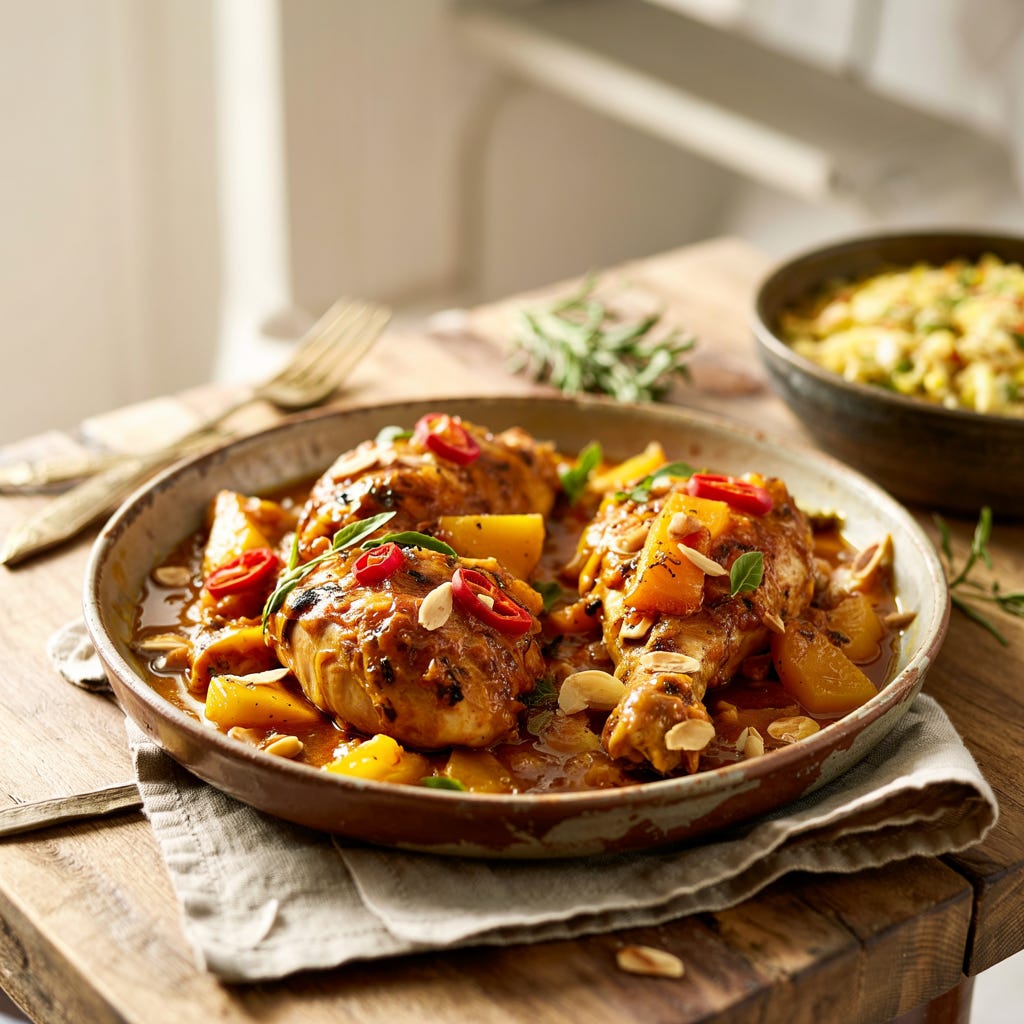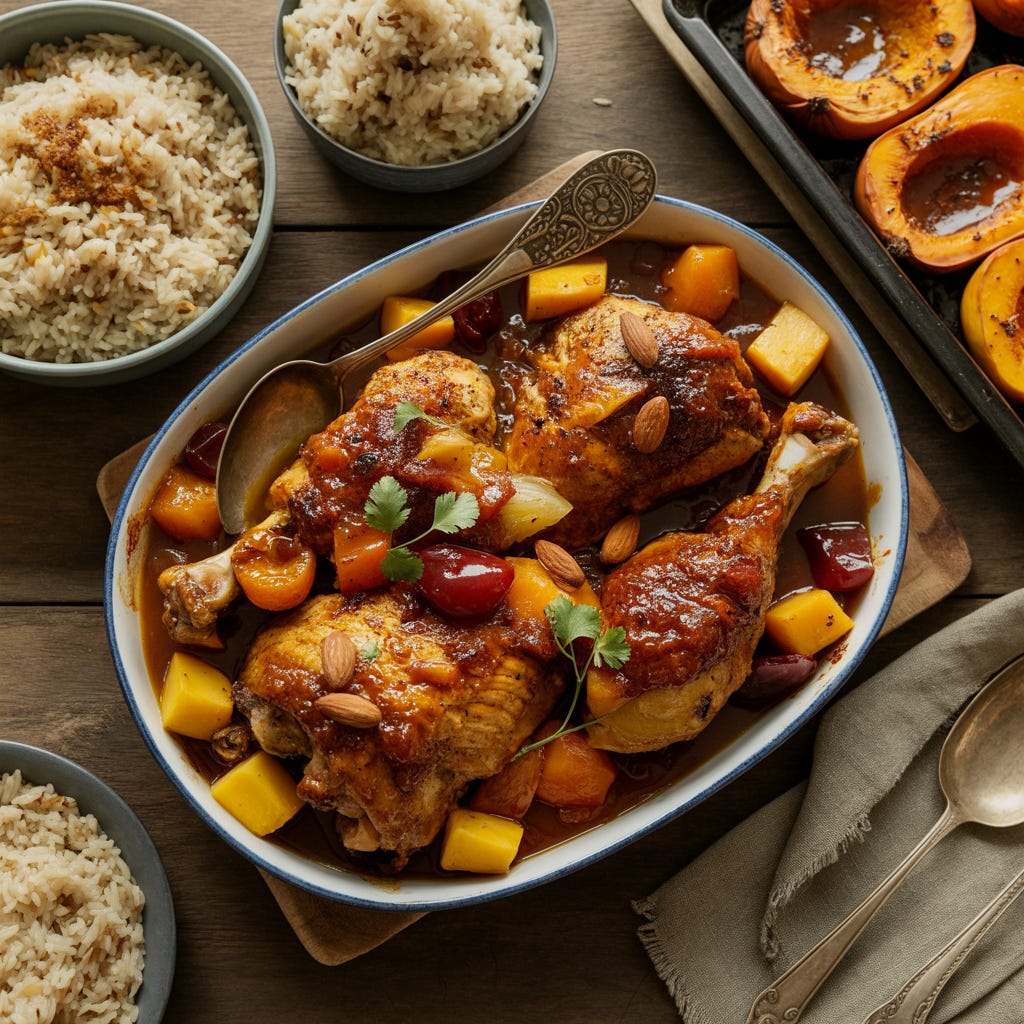Jewish Masala: The Birth of the Jewish Curry Culture Club
and a South African Chutney Chicken Recipe
I want to share something with you, dear readers, for discussion and flavour.
At first, about 4 months ago, I just wanted to write a better Jewish Indian cookbook.
And I wasn’t wrong. There is a need for it, before this whole kitchen is lost.
Often I have been told it`s too niche.
I never let it get me down.
But I wasn’t seeing the full map either.
And so what began as a journey into Baghdadi Indian cooking has evolved into something far spicier, broader, and bolder.
The more I stirred the pot, the wider and deeper it got.
Because as soon as I said the word curry, hands went up — not just in Kolkata or Mumbai but in Cochin, Singapore, Myanmar, Indonesia, Japan, and, as we will shortly see, Cape Town, South Africa.
Jewish curry is not just a cuisine with a story. It’s a diasporic flavour map. A Sephardi satellite. A spice trail etched across oceans.
Restricting the story to India left out a whole world of Jewish food that’s never been folded into a single book.
So today I’m launching a new kind of JCC:
Not the Jewish Community Center — but the Jewish Curry Culture Club.
No membership fees. No dress code. No need to be Jewish. Just a hunger for a good story and the love of a good curry.
That’s how the idea for the Jewish Curry Culture Club was born.
🧭 A Curry Compass: Beyond Babylon to the Cape
Take South Africa. The Jewish community there is overwhelmingly Ashkenazi — Lithuanian in origin — and yet they didn’t remain locked in gefilte ghettoes.
They encountered Indian food at every turn. Durban is the largest Indian city outside India. Spice markets, street foods, and a love of chutneys saturated the air.
And then came the fusion:
Chutney chicken — a dish that feels Jewish, but also South African, also Indian, also British. It’s made with fruit chutney (usually Mrs. Ball’s), Madras curry powder, and often baked in the oven for Shabbat.
Some call it an Ashkenazi curry. It’s what happens when Indian indentured labor, colonial pantry staples, and Jewish homemaking meet on the same plate.
And it deserves a place in the Jewish Curry Culture Club — right alongside Baghdadi lamb curries, Cochini fish stews, and Burmese coconut noodles.
If you’ve ever stirred curry into a Shabbat meal… If you’ve ever wondered why Jewish food seems to stop at brisket or falafel… Then this club is for you. Not just to share recipes. But to share spice stories.
🧂 The Jewish Twist on Mrs. Ball’s Legacy
Mrs. H.S. Ball’s Chutney is iconic. But did you know a Jewish entrepreneur was behind its rise?
Cape Town businessman Fred Metter saw the potential of Amelia Ball’s homemade chutney, originally sold at church bazaars, and turned it into a household name. He built the factory, chose the label and the octagonal bottle, and helped the brand go global.
As Shelley Garb, his granddaughter, explains: “It’s a part of my family’s story.”
So when Jewish homes in Cape Town added chutney chicken to their Shabbat tables, they weren’t just tasting Indian influence — they were tasting Jewish enterprise folded into colonial history.
I first became aware of chutney chicken through the Myrna Rosen South African Jewish Cookbook—a modest, spiral-bound volume passed around Jewish households in Johannesburg and Cape Town, often annotated with smudges and substitutions.
Myrna Rosen was more than a home cook; she was a quiet chronicler of how South African Jewish food evolved at the intersection of Ashkenazi memory, British colonial habits, and the sweet-spiced boldness of local Cape flavors. Her chutney chicken wasn’t fancy—it was practical, deeply comforting, and unmistakably South African: baked with Mrs Ball’s chutney, apricot jam, and soup mix.
It reflected a uniquely diasporic sensibility: Ashkenazi in origin, but softened and sweetened by local taste. That first version stuck with me—not because it was haute cuisine, but because it showed me that Jewish curry could come not only from India, but also from Johannesburg kitchens, one spoonful of sticky chutney at a time.
So I cooked it, took it to heart, and brought it to Switzerland with me, where it became a staple at numnum, my beloved restaurant.
Today I share it with you.
🍗 South African Chutney Chicken
Serves: 6
Preparation Time: 30 minutes
Cooking Time: 1 hour 10 minutes
Ingredients
For the Chicken:
1.5 kg bone-in, skin-on chicken pieces (thighs or drumsticks)
1 tsp salt
½ tsp freshly ground black pepper
1 tsp ground turmeric
1 tsp sweet paprika
For the Sauce:
2 tbsp neutral oil (e.g., sunflower or canola)
2 tsp Madras curry powder (I use homemade Carribbean, which I will soon share)
1 cup Mrs. Ball’s Apricot Chutney
1 tbsp French’s or Dijon mustard
1 tbsp honey
(optional) 1 up mayonnaise
Juice of 1 lemon
2 tsp ground cinnamon
1 tsp additional curry powder
½ cup diced mango
½ cup diced papaya
½ cup diced pineapple
2 cups chicken stock or water
For the Garnish (optional):
½ cup toasted almond slivers
2 fresh red chilies, thinly sliced
Fresh coriander leaves
To Serve:
Yellow pea pilau rice
would you like the recipe for this wonderful dish?
🥘 Instructions
Marinate the Chicken: Combine the chicken with salt, pepper, turmeric, and paprika. Coat thoroughly and refrigerate for at least 1 hour, preferably overnight.
Sear the Chicken: Preheat oven to 180°C. In a Dutch oven, heat the oil over medium. Sear the chicken skin-side down until golden brown. Set aside.
Prepare the Sauce: Mix chutney, mustard, honey, lemon juice, cinnamon, Mayo (if using) and additional curry powder. Fold in mango, papaya, pineapple. Pour in stock and bring to a simmer.
Bake the Dish: Return chicken to the sauce. Cover and bake for 1 hour. Uncover, increase temperature to 200°C, and bake 10 more minutes to caramelize.
Garnish and Serve: Sprinkle with almonds, chilies, and coriander.
Serve over pilau rice, with another interesting side, so I have heard:
“We’ve eaten this since we were children growing up in Carletonville. My mother, Cynthia Morton, used to make it for us. I serve it with white rice, a mixed salad and butternut with cinnamon and sugar.”
🔥 Braai It Like a Local: Skewered Chutney Chicken Kebabs
In true South African fashion, you can also braai your chutney chicken. For this Fourth of July or any summer evening, take a cue from the Cape:
Thread marinated chicken onto skewers, alternating with chunks of mango, pineapple, papaya, and even apricot slices. Brush generously with the chutney sauce.
Grill over open flame or charcoal, turning and basting until smoky and slightly charred. The fruit will caramelize, the curry will deepen, and the community will gather — exactly as it should be.
📝 Chef's Note: A braai is more than just a barbecue — it’s a South African celebration of community, heritage, and hospitality. When curry meets coals, you’ve got a new kind of Jewish Shabbat tradition worth savoring.
🌍 Join the Club
The Jewish Curry Culture Club is just getting started. If this story resonated — if it tasted like something old, something new, something Sephardi, something Ashkenazi — pull up a chair.
We’ve got a curry with your name on it.








